Top5SchemaRegistryToolsforEvent-DrivenSystems
2025-10-09
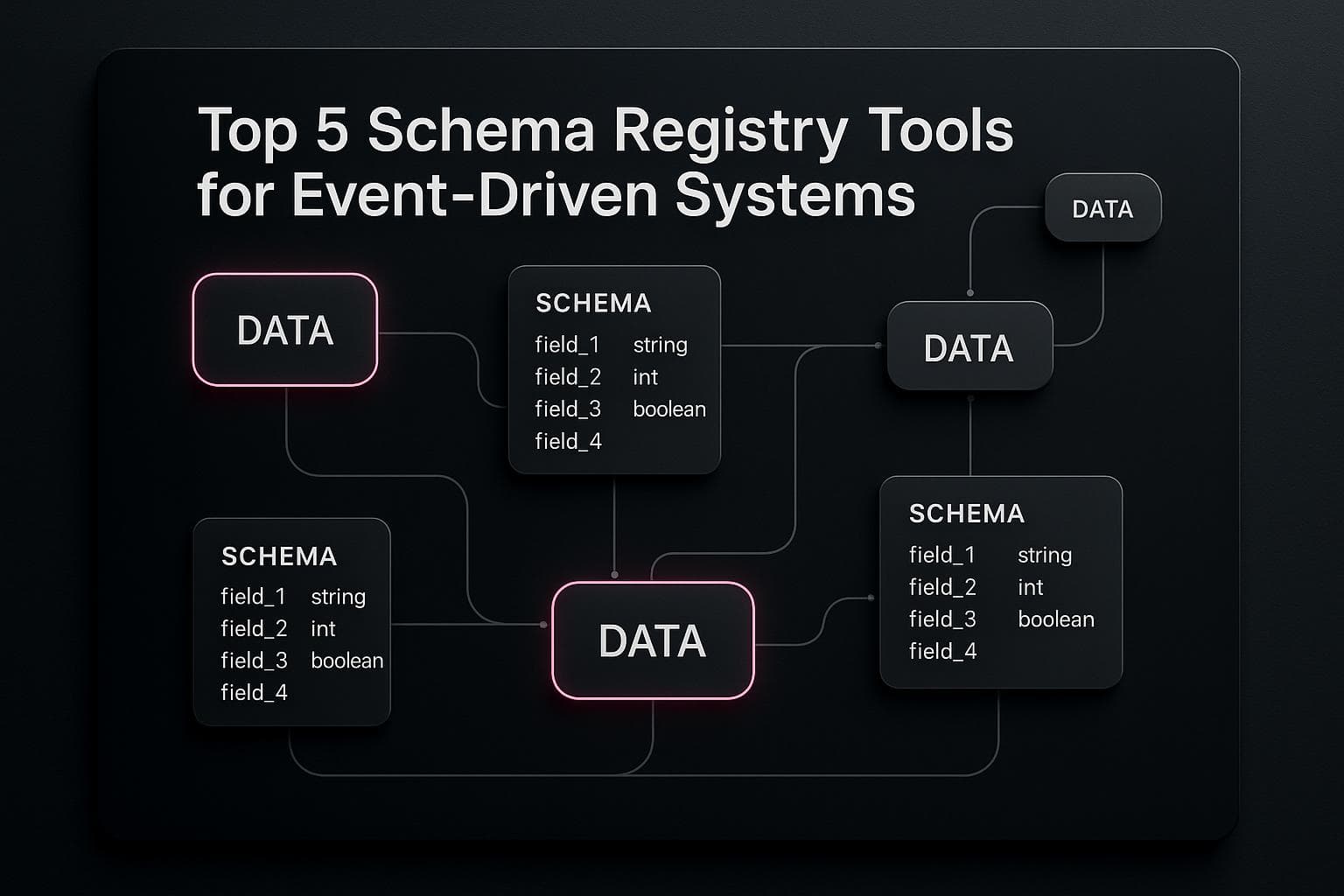
Schema registries are essential for managing data schemas in event-driven systems. They ensure consistent communication between services, support schema evolution, and simplify system upgrades. Choosing the right tool depends on factors like schema format support, deployment options, governance features, and scalability. Here’s a quick look at five widely-used schema registry tools:
- Confluent Schema Registry: Integrated with Kafka, supports Avro, JSON Schema, and Protobuf. Offers robust governance, compatibility modes, and deployment flexibility (cloud or on-premises).
- Solace Schema Registry: Part of the Solace Platform, supports Avro and JSON Schema, with Protobuf support coming soon. Offers flexible deployment options, including customer-controlled regions.
- AWS Glue Schema Registry: Managed service for AWS ecosystems, supports Avro, JSON Schema, and Protobuf. Features automatic schema discovery and IAM-based access control.
- Redpanda Schema Registry: Kafka-compatible, supports Avro, JSON Schema, and Protobuf. Offers cloud-managed and self-hosted deployments with strong performance and governance features.
- Apicurio Registry: Open-source tool supporting multiple formats like Avro, JSON Schema, Protobuf, OpenAPI, and AsyncAPI. Provides flexible deployment options and fine-grained access control.
Each tool caters to specific needs, from cloud-native environments to hybrid systems. Below is a comparison of their key features:
Quick Comparison
| Feature | Confluent | Solace | AWS Glue | Redpanda | Apicurio | |-----------------------------|-----------------------------|-----------------------------|-----------------------------|-----------------------------| | Schema Formats | Avro, JSON, Protobuf | Avro, JSON (Protobuf soon) | Avro, JSON, Protobuf | Avro, JSON, Protobuf | Avro, JSON, Protobuf, OpenAPI, AsyncAPI | | Deployment | Cloud, on-premises | Public, dedicated, customer-controlled | Cloud-only | Cloud, self-hosted | Cloud, on-premises, hybrid | | Governance Features | RBAC, audit logs, validation | Access control, schema evolution | IAM policies, audit trail | RBAC, version management | Fine-grained access, audit logs | | Scalability | High-throughput, multi-region | High-throughput, hybrid setups | Auto-scaling, AWS integration | Sub-millisecond lookups | Horizontal scaling, pluggable storage |
Selecting the right schema registry depends on your infrastructure, compliance needs, and team expertise. For more tailored guidance, visit Antler Digital at antler.digital.
1. Confluent Schema Registry
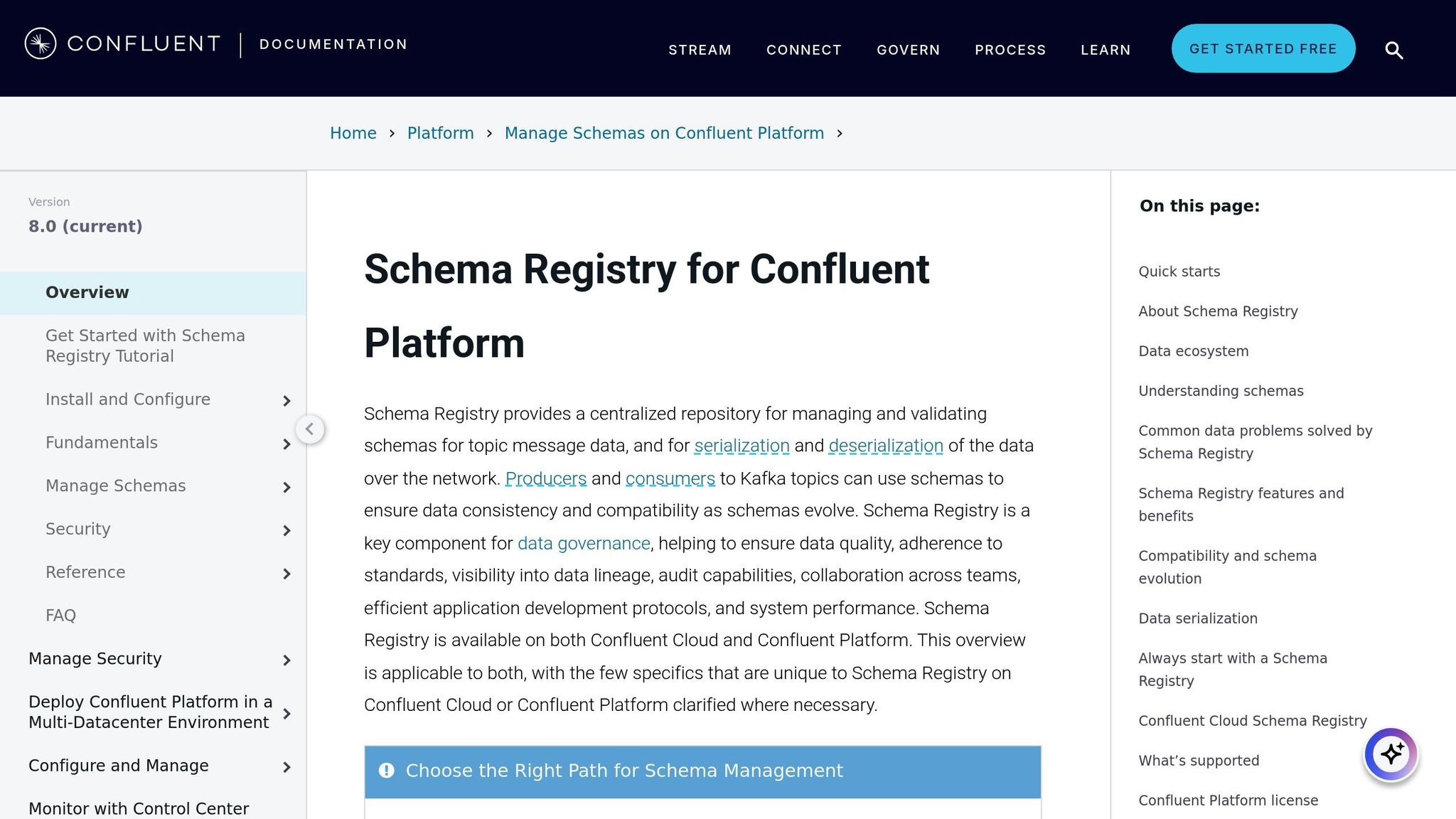
The Confluent Schema Registry, developed by the creators of Apache Kafka, is a widely used tool for managing schemas. It's seamlessly integrated into the Kafka ecosystem, making it a go-to choice for maintaining consistency and scalability in event-driven architectures.
Supported Schema Formats
The Schema Registry supports three key formats:
- Avro: Ideal for compact binary serialisation and managing schema evolution.
- JSON Schema: Suited for REST APIs and web applications.
- Protobuf: Designed for high-performance microservices.
One of its standout features is the enforcement of backward and forward compatibility, allowing schemas to evolve without disrupting existing consumers.
Deployment Models
Confluent Schema Registry offers flexibility in deployment to meet diverse organisational needs:
- Confluent Cloud: A fully managed service that takes care of scaling, security, and maintenance. It’s available globally across major cloud providers like AWS, Azure, and Google Cloud Platform.
- Confluent Platform: An on-premises option for organisations with strict data residency or compliance requirements, offering similar functionality to its cloud counterpart.
These deployment options ensure organisations can maintain robust schema governance regardless of their infrastructure setup.
Governance and Compatibility Features
As systems grow, maintaining governance becomes essential. The Schema Registry provides:
- Role-Based Access Control (RBAC): Integrates with identity providers like Active Directory and LDAP for secure access management.
- Schema Validation and Audit Logs: Prevents breaking changes and ensures compliance across the board.
The compatibility engine enforces schema evolution policies automatically. You can configure it for:
- Backward Compatibility: Ensures new schema versions work with current consumers.
- Forward Compatibility: Allows existing consumers to handle future schema changes.
For advanced scenarios, full and transitive compatibility modes extend these policies across multiple schema versions. Additionally, schema lineage tracking helps map dependencies between schemas and applications, simplifying updates and planning.
Scalability for Event-Driven Systems
In high-throughput event-driven systems, performance is non-negotiable. Confluent Schema Registry is built for speed and scalability:
- Caching and Clustering: Optimised for handling high-volume schema lookups.
- Kafka Integration: Stores schemas in Kafka topics, benefiting from Kafka's durability and scalability.
- Multi-Region Replication: Ensures schemas are accessible across geographically distributed systems, supports disaster recovery, and enables localised access in different regions.
The Registry's REST API further streamlines workflows by integrating schema validation into CI/CD pipelines, enabling automated checks during deployment. This combination of features makes it a powerful tool for managing schemas in complex, distributed environments.
2. Solace Schema Registry
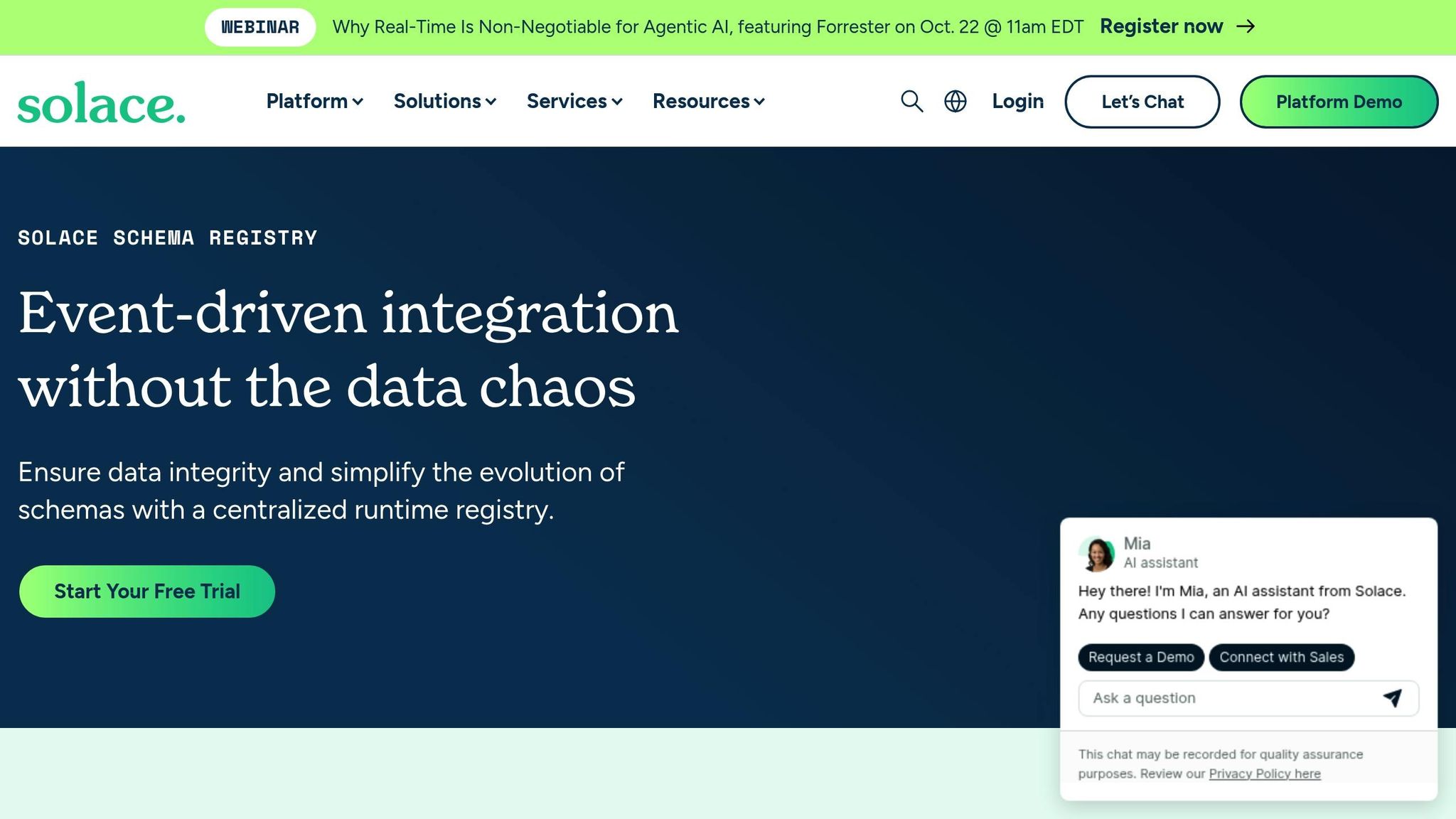
The Solace Schema Registry is an integral part of the Solace Platform, designed for managing schemas in event-driven architectures. Its flexibility across deployment options and schema formats makes it a strong choice for organisations with varied needs in streaming events.
Supported Schema Formats
The registry currently supports Avro and JSON Schema, with Protobuf support on the horizon. This range of formats allows for versatile payload handling. Avro is ideal for scenarios that require compact binary serialisation, while JSON Schema is well-suited for REST API integrations and web applications. The upcoming Protobuf support will address the demands of high-performance microservices. Solace also ensures backward and forward compatibility, keeping schema management smooth and reliable.
"It supports multiple schema formats - including Avro, JSON Schema, and Protobuf (coming soon) - empowering developers to choose the best format for their needs." - Solace
To further enhance its capabilities, Solace is actively expanding its SERDES support to include additional formats.
Deployment Models
Solace offers three distinct deployment models to meet diverse connectivity, isolation, and control requirements: Public Regions, Dedicated Regions, and Customer-Controlled Regions.
- Public Regions: These operate on shared VPC/VNets across AWS, GCP, and Azure, making them a cost-effective choice for development environments or organisations prioritising affordability.
- Dedicated Regions: Designed for single-tenant network isolation, these regions provide a dedicated VPC/VNet managed by Solace. They are ideal for organisations needing secure connectivity to on-premises applications while leveraging managed infrastructure across major cloud providers.
- Customer-Controlled Regions: This option offers the highest level of flexibility, allowing organisations to deploy event broker services within their own Kubernetes clusters. Supported platforms include OpenShift, Rancher, Amazon EKS, Azure AKS, Google GKE, Alibaba ACK, Huawei CCE, and Oracle Kubernetes Engine (OKE).
Scalability for Event-Driven Systems
The Solace Platform is built to handle modern event-driven patterns, including agentic AI and microservices. By enabling real-time communication across distributed systems, it supports high-throughput event streaming, even in complex environments.
Its architecture is tailored for hybrid and multi-cloud setups, ensuring unified management and governance of events and schemas across various infrastructures. The Customer-Controlled Regions deployment model is particularly effective for hybrid event mesh use cases, enabling seamless data exchange between legacy systems and Kubernetes-based applications. This consistent schema management approach strengthens the foundation for robust event-driven architectures.
3. AWS Glue Schema Registry
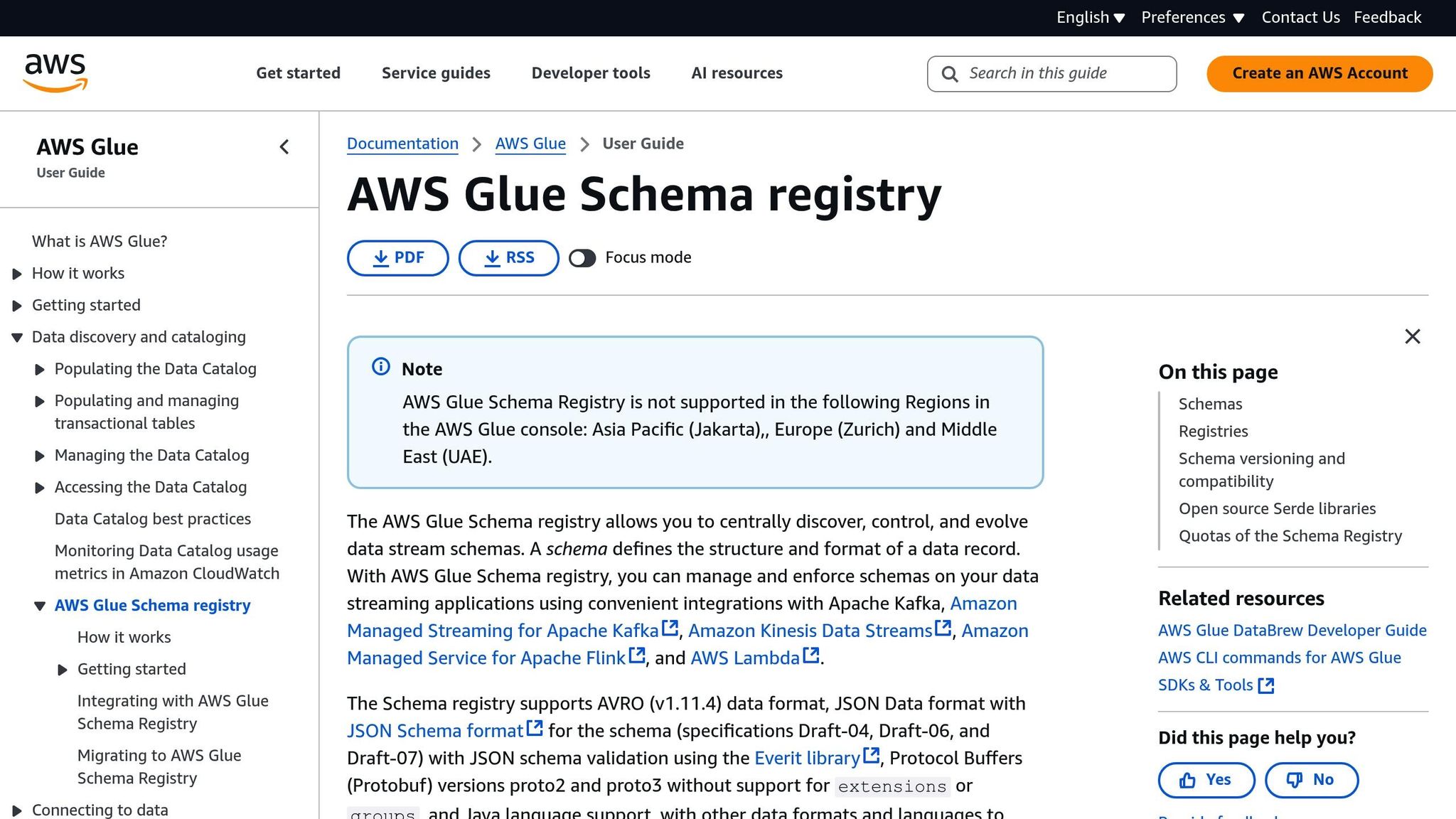
AWS Glue Schema Registry is Amazon's managed schema service, designed to simplify schema governance for streaming applications. It operates as part of the broader AWS Glue service, integrating smoothly within the Amazon ecosystem. This makes it a natural fit for organisations relying on AWS's event-driven architecture.
Supported Schema Formats
The service supports Apache Avro, JSON Schema, and Protocol Buffers (Protobuf), catering to various serialisation needs. It ensures seamless schema evolution, allowing producers and consumers to use different schema versions without disrupting existing workflows. This compatibility safeguards live systems during updates or changes.
Deployment Models
As a fully managed service, AWS Glue Schema Registry runs exclusively on Amazon's cloud infrastructure. This cloud-native design eliminates the hassle of managing updates, scaling, or ensuring availability.
It integrates with key AWS services like Amazon MSK, Amazon Kinesis Data Streams, and AWS Lambda, creating a unified event-driven ecosystem. This tight integration offers operational benefits such as centralised monitoring, consistent security policies, and consolidated billing for organisations already committed to AWS.
However, the cloud-only model may pose challenges for organisations needing on-premises or hybrid deployments, requiring additional planning for connectivity.
Governance and Compatibility Features
AWS Glue Schema Registry also emphasises governance. Using IAM policies, teams can enforce fine-grained access control over schema operations, ensuring strict oversight.
One standout feature is automatic schema discovery, which detects and registers schemas from incoming data streams. This capability is particularly useful when migrating systems or onboarding new data sources into existing architectures.
To prevent issues, the service validates schemas during both serialisation and deserialisation, catching compatibility problems before they impact production. Additionally, it maintains an audit trail of schema changes, which supports compliance efforts and simplifies troubleshooting.
Scalability for Event-Driven Systems
AWS Glue Schema Registry automatically scales to handle varying workloads, ensuring reliability even during peak demand. It integrates with AWS CloudWatch, providing insights into schema usage and performance. This visibility helps teams optimise their event-driven systems by identifying patterns and areas for improvement.
For organisations building on AWS, the Schema Registry offers a cost-efficient solution with a pay-as-you-go pricing model. You only pay for stored schemas and API calls, making it an attractive choice for managing schemas within an event-driven framework.
4. Redpanda Schema Registry
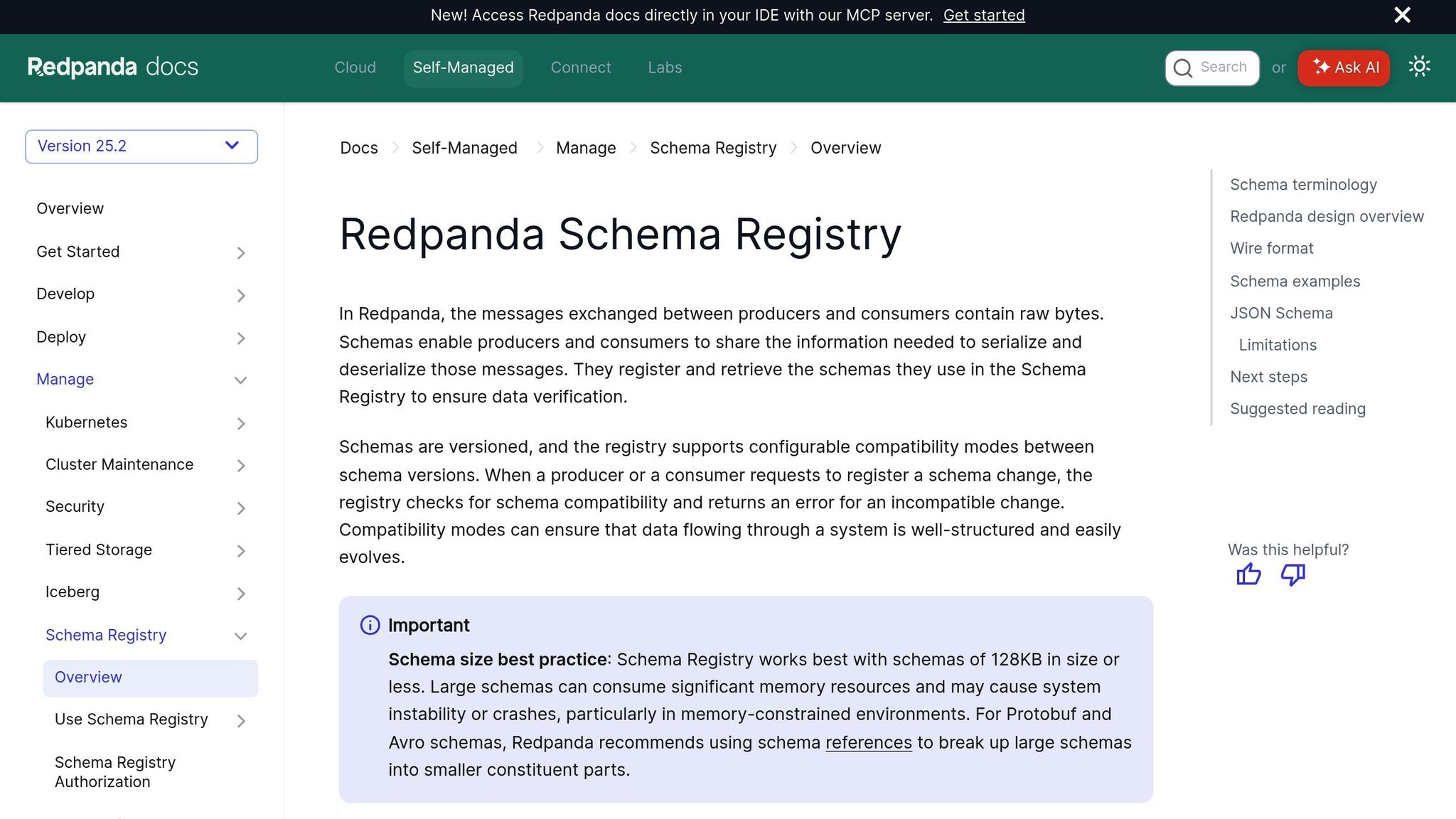
Redpanda has joined the ranks of Confluent, Solace, and AWS by offering its own schema registry, designed with high-performance systems in mind. Redpanda Schema Registry provides Kafka-compatible schema management, combining speed and simplicity with strong governance features. For organisations prioritising operational efficiency, this registry offers a streamlined yet reliable solution.
Supported Schema Formats
Redpanda Schema Registry supports Apache Avro, JSON Schema, and Protocol Buffers (Protobuf), making it versatile enough to handle a variety of serialisation needs. It fully aligns with Kafka's schema evolution patterns, ensuring seamless updates and modifications to schemas without disrupting existing systems.
Its compatibility modes mirror Kafka's, giving teams the flexibility to adapt schema evolution strategies to their specific requirements. This adaptability is crucial for event-driven architectures, where different services often evolve at their own pace.
Deployment Models
Redpanda offers two deployment options: cloud-managed and self-hosted. The self-hosted model is ideal for organisations that need to comply with strict data residency regulations or operate in industries where on-premises deployment is non-negotiable. Additionally, hybrid deployment capabilities allow schemas to be managed across both cloud and on-premises environments, making it suitable for complex infrastructures.
For those opting for cloud deployment, Redpanda provides a fully managed service that takes care of scaling, updates, and maintenance. The service is available on major cloud platforms, including AWS, Google Cloud, and Microsoft Azure, offering global reach and flexibility for distributed teams. This setup is particularly useful during migration projects or for organisations with geographically dispersed operations.
Governance and Compatibility Features
Governance is a key focus for Redpanda Schema Registry. It includes role-based access control (RBAC), enabling teams to define detailed permissions for schema operations. This ensures that schema creation, updates, and deletions are tightly controlled, maintaining governance across both development and production environments.
The platform also offers schema validation at both the producer and consumer levels, catching compatibility issues early and preventing disruptions in live systems. This proactive approach reduces debugging time and guards against data corruption.
Version management tools allow teams to track schema changes over time, with audit logs providing a clear record of modifications. These features not only simplify troubleshooting but also help organisations meet compliance standards by ensuring transparency in schema management.
Scalability for Event-Driven Systems
Redpanda Schema Registry is built to handle the demands of modern, high-throughput event-driven systems. Its architecture ensures sub-millisecond schema lookup times, preventing bottlenecks even during peak loads. The platform is capable of managing millions of schema operations per second without compromising performance.
To handle variable demand, the service automatically scales resources as needed, eliminating the need for manual adjustments during busy periods. Built-in caching further enhances performance by reducing lookup times for frequently accessed schemas.
For monitoring, Redpanda provides real-time insights into schema usage patterns, helping teams spot and address potential performance issues before they escalate. Integration with popular observability tools ensures that schema registry metrics can be seamlessly included in existing monitoring dashboards, providing a comprehensive view of system health and performance.
sbb-itb-1051aa0
5. Apicurio Registry
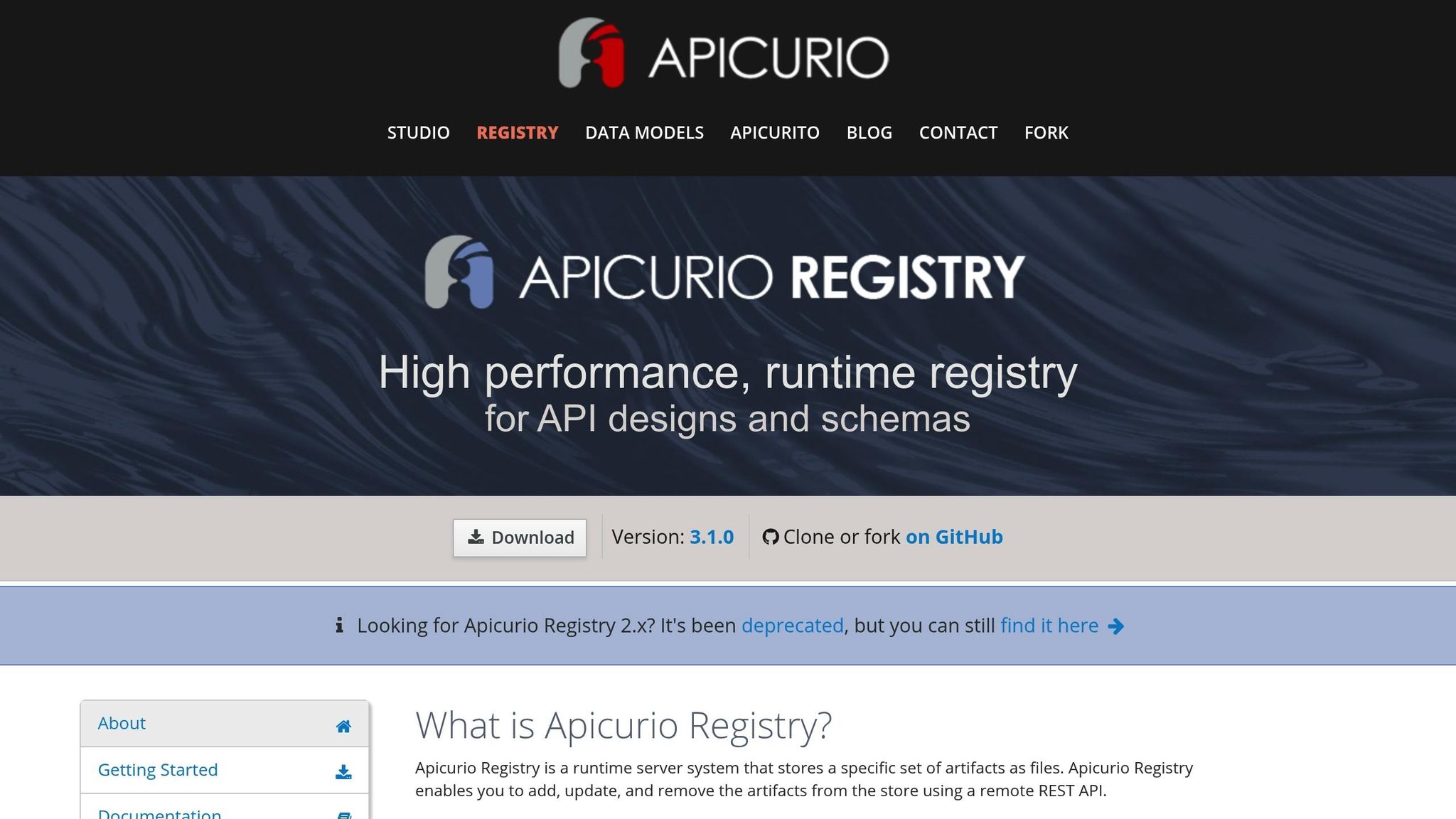
Apicurio Registry stands out as a versatile open-source tool that combines flexibility with a wide range of supported formats and deployment options, making it a solid choice for managing schema definitions without being tied to a specific vendor.
Supported Schema Formats
Apicurio Registry supports a variety of schema formats, including Apache Avro, JSON Schema, Protocol Buffers (Protobuf), OpenAPI, and AsyncAPI. This extensive format compatibility is a major advantage for organisations handling diverse APIs or event streaming requirements. With multi-format support, teams can rely on a single tool for different serialisation needs. Additionally, it allows configurable schema evolution rules per format, enabling compatibility modes like backward, forward, or full compatibility to be tailored to specific use cases. This flexibility makes Apicurio Registry a strong choice for managing schemas across varied API and event-streaming architectures.
Deployment Models
Apicurio Registry is designed with modern operational needs in mind, offering multiple deployment options, including cloud-native, on-premises, and hybrid configurations. With its Kubernetes-first design, the tool simplifies containerised deployments, whether on-premises or in the cloud. This approach also streamlines disaster recovery processes, ensuring minimal downtime and efficient management.
Governance and Compatibility
Beyond its format and deployment capabilities, Apicurio Registry includes essential governance features. These include fine-grained access control and audit logging, which enhance security and traceability. Integration with enterprise identity providers, such as LDAP and OAuth 2.0, allows organisations to use their existing authentication systems seamlessly. The platform also enforces schema lifecycle management by implementing naming conventions and structural requirements, ensuring consistency across registered schemas.
Scalability for Event-Driven Systems
Built to handle demanding workloads, Apicurio Registry supports horizontal scaling and offers pluggable storage backends like PostgreSQL and in-memory options. It also integrates with Prometheus metrics and provides health check endpoints, enabling teams to monitor performance and maintain stability even under heavy usage. These features make it a reliable choice for event-driven systems requiring robust and scalable schema management.
Feature Comparison
When choosing a schema registry tool for your event-driven architecture, it's essential to weigh the supported schema formats alongside any governance or versioning features. Here's a summary of key features across popular tools:
| Feature | Confluent Schema Registry | Solace Schema Registry | AWS Glue Schema Registry | Redpanda Schema Registry | Apicurio Registry |
|---|---|---|---|---|---|
| Schema Format Support | Avro, JSON Schema, Protobuf | Not specified | Avro, JSON Schema, Protobuf | Avro, JSON Schema, Protobuf | Not specified |
| Schema Governance | Centralised schema management, validation, and versioning; supports backward, forward, full, and transitive compatibility, with schema contexts for logical grouping | Not specified | Not specified | Not specified | Not specified |
Confluent, AWS Glue, and Redpanda stand out for their support of Avro, JSON Schema, and Protobuf formats. However, governance features set Confluent apart. It offers centralised schema management, validation, and versioning, with compatibility options such as backward, forward, full, and transitive. These can be fine-tuned globally or per subject. Additionally, its schema contexts enable logical grouping, making it a robust option for complex architectures.
Conclusion
Schema registries play a crucial role for UK organisations developing event-driven systems. They ensure reliable data exchange, allowing microservices to communicate efficiently while maintaining data integrity and system stability. With a variety of tools available, organisations have the flexibility to choose a solution that fits their unique operational needs.
Each tool brings something distinct to the table - whether it's Confluent's strong governance features, AWS Glue's integration with cloud services, Redpanda's compatibility with Kafka, Solace's focus on messaging, or Apicurio's adaptability for customisation.
When choosing a schema registry, organisations in the UK should focus on factors like compatibility, supported schema formats, and governance capabilities. It's also important to consider team expertise, compliance requirements, and the potential for future scalability. As highlighted in this guide, making a thoughtful investment in schema management reduces integration challenges and improves overall efficiency.
For those looking to implement these tools effectively, expert support can make the process smoother. To explore how these solutions can fit into your event-driven architecture, check out the tailored services offered by Antler Digital (https://antler.digital).
FAQs
What should I consider when selecting a schema registry tool for my event-driven architecture?
When choosing a schema registry tool for your event-driven architecture, there are a few key factors to keep in mind. Schema validation and versioning capabilities are at the top of the list. These features ensure your data remains consistent and make it easier to manage changes to schemas, keeping your system reliable as it evolves.
It's also worth checking if the tool supports backward and forward compatibility. This ensures that consumers can handle schema updates without needing immediate adjustments, reducing potential disruptions. Centralised schema management is another advantage to look for, as it simplifies updates and ensures compatibility across your system, making it more adaptable to future needs.
Lastly, think about how well the tool integrates with your current tech stack and whether it can scale as your system grows. Picking the right schema registry tool can significantly improve the efficiency and dependability of your event-driven workflows.
Why is schema compatibility important for evolving schemas in event-driven systems?
Schema compatibility plays a key role in keeping event-driven systems running smoothly. It ensures that newer schema versions can work alongside older ones without causing issues for existing consumers, allowing seamless communication throughout the system.
There are two main types of compatibility to consider. Forward compatibility means newer consumers can still process events created with older schemas. On the other hand, backward compatibility ensures that older consumers can handle events generated with newer schemas.
To manage schema updates without disruptions, strategies like introducing nullable fields or setting default values can be highly effective. These methods help avoid breaking changes and maintain data integrity. By taking this approach, you can evolve schemas over time while keeping the system stable and ensuring everything continues to work together smoothly.
What are the benefits of choosing a cloud-managed schema registry over a self-hosted one?
Choosing a cloud-managed schema registry comes with several advantages over managing one yourself. For starters, it takes the hassle out of dealing with infrastructure. The provider takes care of everything - scaling, maintenance, and updates - so you can focus on what matters most without getting bogged down in operational tasks. This approach not only saves time but also cuts down on resource demands.
Another major plus is reliability and security. Cloud-managed registries offer regular updates, automatic backups, and high availability as standard. On the other hand, self-hosted solutions demand dedicated expertise to achieve the same level of performance and protection. For organisations prioritising simplicity and scalability, especially in fast-moving or large-scale settings, cloud-managed options often make the most sense.
Lets grow your business together
At Antler Digital, we believe that collaboration and communication are the keys to a successful partnership. Our small, dedicated team is passionate about designing and building web applications that exceed our clients' expectations. We take pride in our ability to create modern, scalable solutions that help businesses of all sizes achieve their digital goals.
If you're looking for a partner who will work closely with you to develop a customized web application that meets your unique needs, look no further. From handling the project directly, to fitting in with an existing team, we're here to help.
